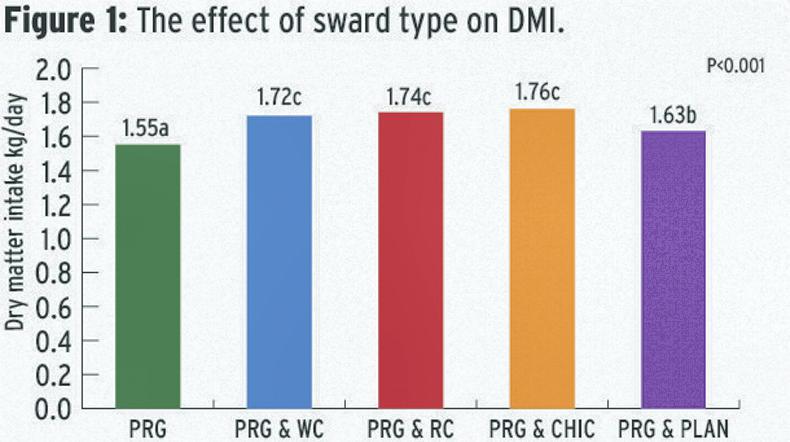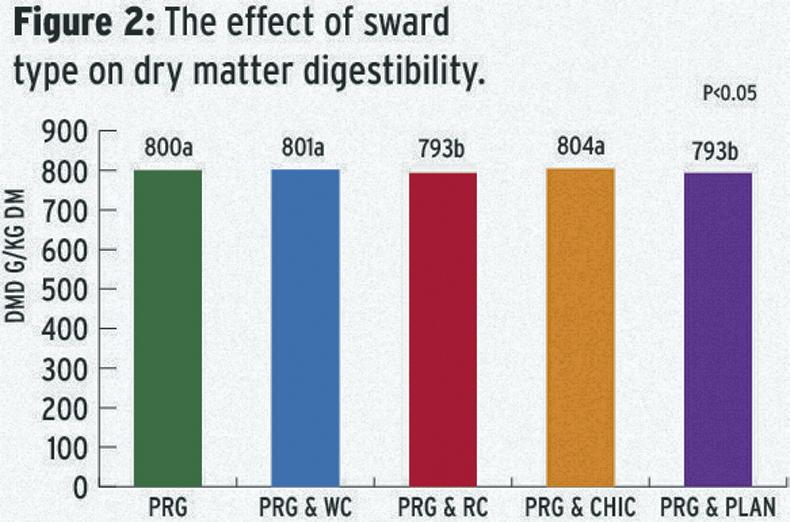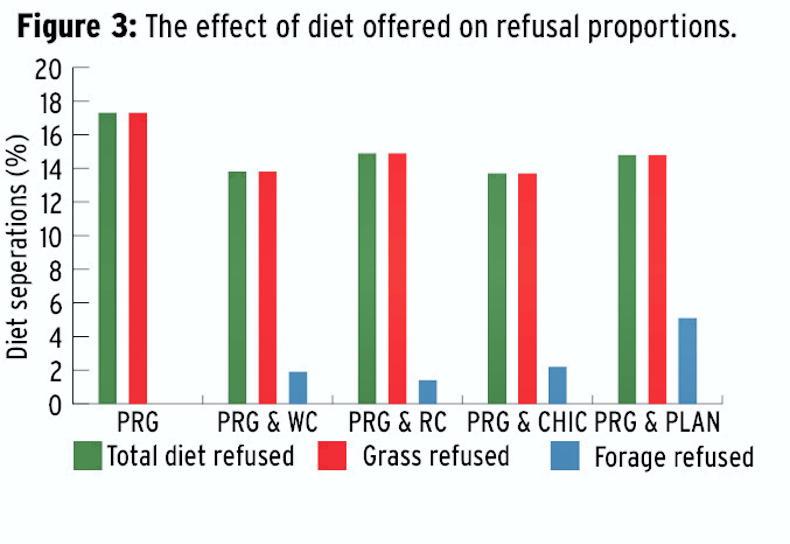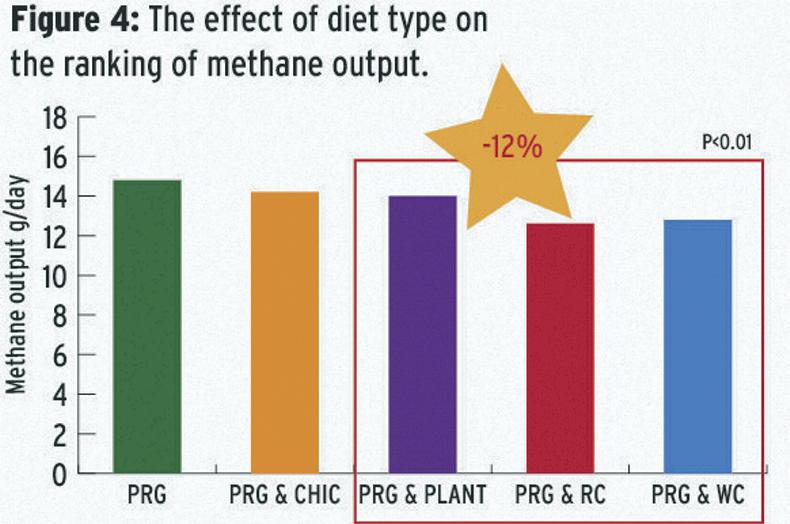A number of trials carried out in recent years have shown that sheep grazing multispecies or combined grass herb/legume swards have the potential to achieve higher levels of performance compared to grass-only swards.
A number of possible contributors to animals achieving higher performance have been mooted and include a higher dry matter intake, increased dry matter digestibility (DMD) and enhanced health benefits.
Preliminary results from a recent trial evaluating the effect of sward type on dry matter intake (DMI) and DMD have shown that animals offered a grass diet, along with a companion forage, recorded a 5% to 14% higher DMI compared to animals consuming a perennial ryegrass-only diet.
Trial metrics
There were 20 Belclare wether hoggets weighing an average of 65kg liveweight included in the trial. Five dietary treatments were included as follows – perennial ryegrass (PRG), PRG and white clover (WC), PRG and red clover (RC), PRG and chicory (Chic) and PRG and plantain (Plan).
The sheep were monitored over five feeding periods and were offered zero grazed herbage in metabolism crates. Animals were housed in open individual pens for two days and then transferred to the metabolism crates.
The first two days of the trial (day three to five) were an adaptation period where animals got accustomed to the diet they were being offered.
Records were then collected for six days (day six to 12) and at this stage, the sheep were returned to group grazing for 72 hours. The whole process then began again, and this was repeated to deliver five feeding periods.
The companion forage was offered at 25% of the inclusion rate to PRG, as this 25:75 ratio was seen to best match the sward content in a well-established sward.
Forage was cut fresh and any uneaten material was removed and weighed. Animals were offered 10% above the level consumed to avoid a scenario of animals consuming all the forage and not knowing what the potential intake might have been on any given day.
Preliminary results
Fiona McGovern, Teagasc, was the lead researcher on the trial, while Teagasc PhD student Sarah Woodmartin oversaw the day-to-day running of the trial.

Teagasc sheep researcher Fiona McGovern.
Figure 1 shows the effect of sward type on DMI. The PRG and Chic treatment recorded the highest DMI of 1.76kg per day. This was 14% higher than the PRG-only sward, which recorded the low intake of 1.55kg daily. There were also significant differences with white and red clover, with DMI 12% and 11% higher respectively. The PRG and Plan treatment recorded 5% higher DMI.

Explaining the preliminary results, Fiona said: “We had seen from Philip Creighton’s, Sarah Woodmartin’s and Lisa McGrane’s work, the higher potential performance from lambs grazing companion forage diets.
“We expected that an increase in DMI was a significant contributor, as sheep are selective grazers and anything different in the diet which is palatable will generally encourage them to eat more. These forages also have a higher percentage of leaf compared to ryegrass, which would make them a more attractive feed.”
Dry matter digestibility
Figure 2 details the effect of sward type on DMD. The PRG and Chic diet was shown to have the highest DMD of 80.4%. This was marginally ahead of PRG and WC at 80.1% and 80%, respectively. Fiona says that while there was a statistical difference between these three diets and the PRG and RC/PRG and Plan diet, biologically there was no difference.

As detailed in Figure 3, there were only marginal differences between the volumes of companion forages refused. The lowest refusal rate was with the PRG and WC and PRG and Chic diets. This ties in with field experience, with sheep tending to prioritise the grazing of white clover and chicory first.

Methane output
An added component of the trial looked at the effect of the different diet types on greenhouse gas emissions. Analysing such information takes a significant length of time, but preliminary estimates on the effect of diet type on methane output are detailed in Figure 4.

There was a 12% reduction in methane output in grazing the clover and plantain diets compared to chicory and PRG.
The research backs up the results from previous studies demonstrating the potential to improve animal performance by incorporating clover and herbs in mixed species or grass-companion forage swards.
There are ongoing persistency challenges with the herbs, with chicory and plantain struggling to compete in swards and persist at the same level in a sward beyond a two-year period.
Further research is taking place on grazing techniques, which will be beneficial.
Some farmers are taking the view that if they incorporate herb and clover mixes into the sward during a reseeding programme, even if the herbs do not persist they will be happy if they are left with a good grass-clover sward, while others are concentrating on establishing good grass-clover swards given there is no major differences being identified in DMI or digestibility.
This leaves aside discussions on animal health benefits from herb mixtures, but further research is needed in this area to quantify exactly what benefits exist.
A number of trials carried out in recent years have shown that sheep grazing multispecies or combined grass herb/legume swards have the potential to achieve higher levels of performance compared to grass-only swards.
A number of possible contributors to animals achieving higher performance have been mooted and include a higher dry matter intake, increased dry matter digestibility (DMD) and enhanced health benefits.
Preliminary results from a recent trial evaluating the effect of sward type on dry matter intake (DMI) and DMD have shown that animals offered a grass diet, along with a companion forage, recorded a 5% to 14% higher DMI compared to animals consuming a perennial ryegrass-only diet.
Trial metrics
There were 20 Belclare wether hoggets weighing an average of 65kg liveweight included in the trial. Five dietary treatments were included as follows – perennial ryegrass (PRG), PRG and white clover (WC), PRG and red clover (RC), PRG and chicory (Chic) and PRG and plantain (Plan).
The sheep were monitored over five feeding periods and were offered zero grazed herbage in metabolism crates. Animals were housed in open individual pens for two days and then transferred to the metabolism crates.
The first two days of the trial (day three to five) were an adaptation period where animals got accustomed to the diet they were being offered.
Records were then collected for six days (day six to 12) and at this stage, the sheep were returned to group grazing for 72 hours. The whole process then began again, and this was repeated to deliver five feeding periods.
The companion forage was offered at 25% of the inclusion rate to PRG, as this 25:75 ratio was seen to best match the sward content in a well-established sward.
Forage was cut fresh and any uneaten material was removed and weighed. Animals were offered 10% above the level consumed to avoid a scenario of animals consuming all the forage and not knowing what the potential intake might have been on any given day.
Preliminary results
Fiona McGovern, Teagasc, was the lead researcher on the trial, while Teagasc PhD student Sarah Woodmartin oversaw the day-to-day running of the trial.

Teagasc sheep researcher Fiona McGovern.
Figure 1 shows the effect of sward type on DMI. The PRG and Chic treatment recorded the highest DMI of 1.76kg per day. This was 14% higher than the PRG-only sward, which recorded the low intake of 1.55kg daily. There were also significant differences with white and red clover, with DMI 12% and 11% higher respectively. The PRG and Plan treatment recorded 5% higher DMI.

Explaining the preliminary results, Fiona said: “We had seen from Philip Creighton’s, Sarah Woodmartin’s and Lisa McGrane’s work, the higher potential performance from lambs grazing companion forage diets.
“We expected that an increase in DMI was a significant contributor, as sheep are selective grazers and anything different in the diet which is palatable will generally encourage them to eat more. These forages also have a higher percentage of leaf compared to ryegrass, which would make them a more attractive feed.”
Dry matter digestibility
Figure 2 details the effect of sward type on DMD. The PRG and Chic diet was shown to have the highest DMD of 80.4%. This was marginally ahead of PRG and WC at 80.1% and 80%, respectively. Fiona says that while there was a statistical difference between these three diets and the PRG and RC/PRG and Plan diet, biologically there was no difference.

As detailed in Figure 3, there were only marginal differences between the volumes of companion forages refused. The lowest refusal rate was with the PRG and WC and PRG and Chic diets. This ties in with field experience, with sheep tending to prioritise the grazing of white clover and chicory first.

Methane output
An added component of the trial looked at the effect of the different diet types on greenhouse gas emissions. Analysing such information takes a significant length of time, but preliminary estimates on the effect of diet type on methane output are detailed in Figure 4.

There was a 12% reduction in methane output in grazing the clover and plantain diets compared to chicory and PRG.
The research backs up the results from previous studies demonstrating the potential to improve animal performance by incorporating clover and herbs in mixed species or grass-companion forage swards.
There are ongoing persistency challenges with the herbs, with chicory and plantain struggling to compete in swards and persist at the same level in a sward beyond a two-year period.
Further research is taking place on grazing techniques, which will be beneficial.
Some farmers are taking the view that if they incorporate herb and clover mixes into the sward during a reseeding programme, even if the herbs do not persist they will be happy if they are left with a good grass-clover sward, while others are concentrating on establishing good grass-clover swards given there is no major differences being identified in DMI or digestibility.
This leaves aside discussions on animal health benefits from herb mixtures, but further research is needed in this area to quantify exactly what benefits exist.











 This is a subscriber-only article
This is a subscriber-only article











SHARING OPTIONS: